It’s winter in Maryland. In fact, it’s so much winter I shoveled 10 inches of snow off my driveway this morning. Fortunately, I had company. It wasn’t the kind of company that picks up a shovel and helps out, but still, the American robins darting back and forth over my head were still welcome (if surprising and surprisingly quiet) snow day companions.
Become a Member
Make a lasting impact for nature when you join The Nature Conservancy
“You know,” I said to them as I leaned on my shovel to watch about 25 birds flock together in my neighbor’s oak. “I think y’all are a little early—aren’t you supposed to be the first harbingers of spring?”
We’re not even a month past the first day of winter in the northern hemisphere. Spring is definitely not here. So why are the robins? Shouldn’t they be sunning themselves in warmer climes?
The short answer: as long as there’s food, American robins—true to their name Turdus migratorius (“the wandering thrush”)—kind of spend their winters coming and going as they please.
Robin Migration (AKA Robin Wandering)
Robins do migrate—but they don’t necessarily follow a more or less straight line from north to south in the fall, then repeat the journey south to north in the spring. In the fall and winter, when the ground freezes, robins lose access to their meal of choice: worms, insects (adult and larval) and (occasionally) snails. That’s when they turn to their winter diet staple: mostly fruit, mostly berries.
The folks at Journey North, a project tracking robin movements run by the University of Wisconsin-Madison, put it this way, “Some robins retreat all the way to southern Texas and Florida (in fact, some of the largest winter flocks documented by the Christmas Bird Count gather in sunny St. Petersburg, Florida), but others winter as far north as they can find berries. So they have an enormous winter range. Robins do migrate, but it has more to do with food sources than with being faithful to the same places year over year.”
In that way American robins are somewhat akin to teenage boys—they tend to go where the best (or most abundant or most easily accessible) food is, stay until it’s depleted, and then move on.
So as long as there are enough berries and other fruits to sustain them, you may see robins off and on throughout the winter across much of North America.
Forget the birdseed though. Robins’ digestive systems, unlike sparrows or other so-called feeder birds, aren’t built for dealing with seed, and their beaks aren’t built for cracking things open. Robin beaks are built for snapping up worms, catching insects, and plucking berries and other fruits. In the winter, a flock of robins can strip a holly bush with impressive speed and efficiency, and very little—if any—violent robin-on-robin aggression.
Food is also one of the reasons that robins, notoriously territorial and aggressive in breeding season, tend to gather and travel in flocks in the fall and winter. Numbers are good for defense, and also for spotting food—if one robin happens on a holly tree full of bright, ripe berries, the whole flock can partake. And then move on.
The tendency of robins to flock in winter may also be one of the reasons people seem to notice them—birds in large numbers tend to stand out when they’re gathered in leafless trees. (That and the beautiful red breast that is sometimes the only splash of color in a winter landscape that looks practically lunar in relentless shades of February white and gray.)
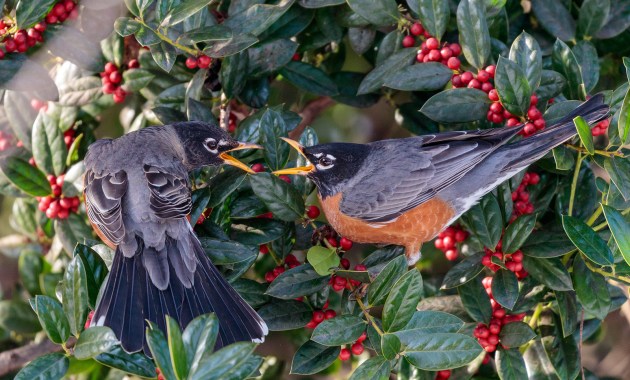
How do Robins Survive the Cold?
Robins are outfitted to survive huge temperature variances. In fact, hot weather seems to stress them more than cold.
If an American robin is healthy, has enough to eat, and is able to main its feathers, the temperature next to its body stays around 104 F—regardless of how cold it is in the world outside. It really is all about those feathers. (And the legs and feet.)
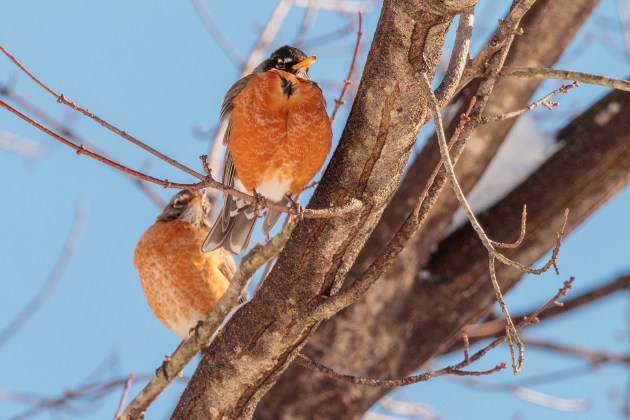
Robins, like most birds, have layers of feathers that perform different functions. When temperatures drop, robins puff the fine, downy feathers closest to their bodies to keep heat in, cold out. The outer feathers act like a kind of overcoat, shedding water and moisture and helping to regulate the bird’s temperature. (It’s an adaptation not limited to robins. Most birds with down feathers fluff them to regulate body heat).
The anatomy of a robin’s (and other bird species) also contributes to their cold adaptations. The bird experts over at the Cornell Lab explain it very well. The simplified version is that “most birds don’t succumb to frostbite because there is so little fluid in the cells of their feet, and their feet are mostly tendons and bones with little muscle or nerve tissue.”
So while blood does flow to their legs and feet, most birds (including robins) benefit from a very fast circulatory system and a “countercurrent heat exchange system.” Because bird legs are thin, the vessels that move blood from the heart to the feet and back again are very close together. That proximity means, per Cornell, “blood flowing back to the body is warmed by blood flowing to the feet. The newly cooled blood in the feet lowers heat loss from the feet, and the warmed blood flowing back into the body prevents the bird from becoming chilled.”
Robins: The Tell-Tale Birds of Spring
If robins are around in winter, why have they always been associated with the beginning of spring in the U.S.? Most likely it has to do with ground thaw, snow melt, and territorial behaviors like singing, worm hunting and nest building. But mostly, it’s the singing.
According to Journey North, which has a fantastic Q+A section I highly recommend for the robin-curious, “the robin’s song remains a reliable indicator that the first wave of spring migration has reached you. This song is one of the first signs that robins are switching from winter behavior to courtship and nesting behaviors associated with spring.”
Robins tend to move north as the ground thaws. The availability of high protein prey, especially worms that emerge with warmer, often wetter weather, is when a robin’s thoughts turn to procreation. And that’s the end of the cooperative fall and winter behaviors.
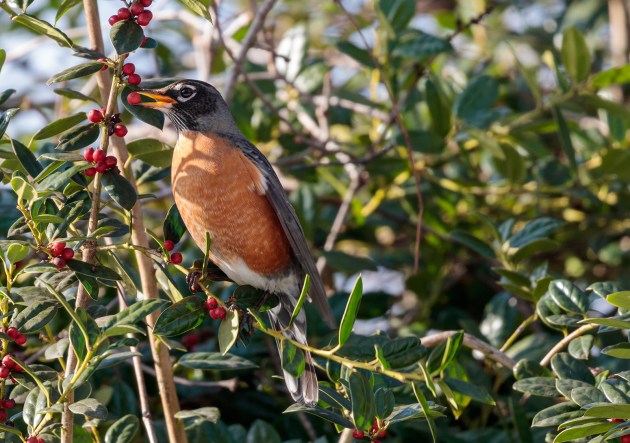
Which is one of the reasons many robins (primarily males) may stay through harsher winters instead of booking it to St. Petersburg: first access to the choicest nesting grounds. Breeding season is when robins also become more visible with mating displays, nest-building and a lot of time on the ground hunting for the tastiest worms. Until then, they’re all about the berries.
You Can Help Robins with Science from Your Own Backyard
Like many species, including other birds, scientists are starting to see some changes in robin behavior that is likely attributable to climate change. One study of American robins migrating to and from Canada’s boreal forest, showed that they’re beginning to journey south on average about 12 days earlier than in past years, or five days earlier per decade since 1994.
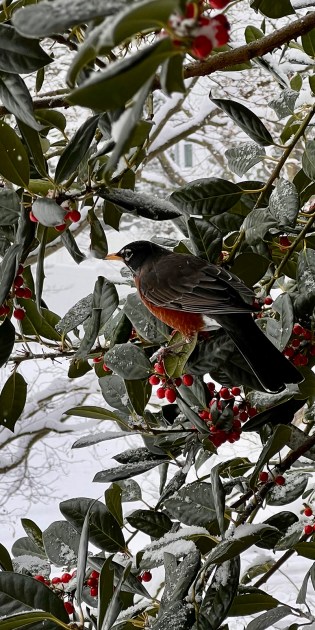
If you want to help scientists studying birds, there are several ways to contribute your observations (not just for robins, but for many of the species you can see outside your windows).
Journey North
You can submit your robin observations directly on the Journey North site (and check out their other migration-related citizen science projects). They also have 2025 maps tracking sightings so you can see where American robins (and other signs of spring) are being observed and follow along (and contribute to) the wanderings of Turdus migratorius.
Cornell Lab of Ornithology
The Cornell Lab has a number of different ways you can contribute to science for birds. Your sightings tracked on eBird (free) contribute to worldwide data for birding, science, and conservation. Want to know what birds are being seen in your neighborhood, eBird has a feature for that. If you’re new to birding, check out their genius birding ID app, Merlin.
You can also contribute to Project FeederWatch (requires subscription) by counting birds at your feeder from November through April. Your observations help scientists monitor changes in the abundance and distribution of birds, including the influence of changes in habitat, disease, and climate.
And mark your calendars for the 2025 Great Backyard Bird Count (February 14-17). Spend time in your favorite places watching birds—then report them to Cornell! It’s easy to participate, “in as little as 15 minutes notice the birds around you. Identify them, count them, and submit your counts to help scientists better understand and protect birds around the world. You can see the results from 2024 here.
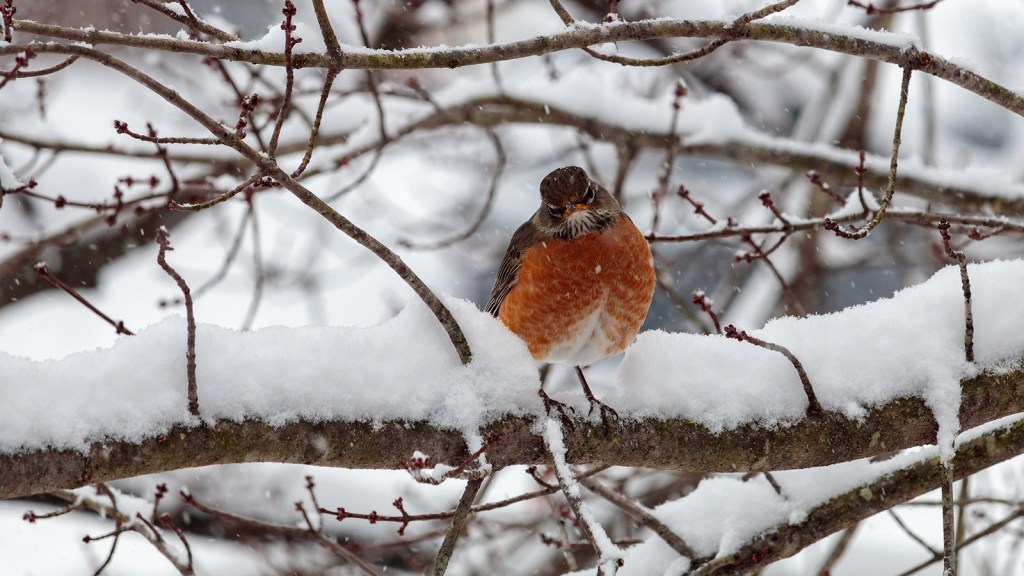



I saw my first two robins today . I live in Manalapan N.J. and we are in the middle of a snowstorm . My robins always return about mid-March and somehow arrive in or around a snowstorm . This is a little early for them. I thought perhaps in another week but they are back. I’m happy!!
Hello! I am from England originally and the English Robin is quite different, smaller with a true red breast, therefore called Robin Red Breast. I grew up learning this rhyme and thought you might enjoy it too. “The North wind doth blow, and we shall have snow, and what will the Robin do then? poor thing.
He’ll sit in the barn, to keep himself warm, and tuck his head under his wing, poor thing.” I love all the British nursery rhymes and neat things like this. I certainly enjoyed reading all about the Robins in these articles and yes, love watching them in my bird baths and the sprinkler when ready. Right now, it is very cold and snowing off and on and no Robins yet. hugs to keep us warm and love for all our animals and feathered friends.
Robins here in the Pacific Northwest seem to nest on the ground (?? under ferns and other bushes) instead of in trees…..is this possible. When driving by an area when they are, the adults seem to fly briefly in front of car and then off into the distance, but low to the ground. Are they trying to lead a perceived predator away from their nest site? We have several robins in our yard now – in Puget Sound area— digging for worms …. they look like males. We use our ~3/4 acre to consistently provide water, food and habitat for birds of all kinds, as well as other wildlife, and have as many trees growing on our property as possible.)
Hi T J, Thank you! Yes, robins do sometimes nest on the ground, especially in western prairies – https://www.allaboutbirds.org/guide/American_Robin/lifehistory and others have observed “distraction display” behavior in robins: https://qedinsight.wordpress.com/2011/06/11/distraction-displays-of-backyard-robins/
I saw robins today, recent arrivals I’m guessing. Because you can see robins in winter nowdays, I look to red wing blackbirds now as my goto for a sign of spring.
We have a Robin that flies & splats into our window. When it hits the window, it then drops to the ground and then jumps up about 8 ” to the window sill. He does this over and over. When he hits the window it seams as though he could not survive the hit, but he does. This goes on for a very long time.
I love robins. About 35 years ago I raised one successfully by feeding him moistened dog kibble. I became his “mom”. If he heard my voice he would starting “cheeping” for food. We were able to let him go but he hung around for a while. Maybe 10 or 15 years ago, one of my sons also raised one successfully by feeding him dog kibble.
I lived in Wisconsin and Minnesota for many years and found what feeds the robins through the winter are the noxious common buckthorns, (rhamnus cathartica) an exotic (non-native) very invasive small tree from Europe. They were introduced way back in the mid1800’s as hedge plants. They have a survival plan- they leaf out early and lose leaves late so have a competitive edge over any poor native oak trying to germinate. They have those berries that have a purple -blue flesh over a round seed. The birds thrive on them, give the seeds an acid bath and seeds go everywhere and also drop right under the tree, making for a very dense stand of shade. Maples can grow in the shade, not oaks. This is changing the make up of the woods.
It is hard to control all the buckthorn around but it can be done area by area with cutting and herbiciding large trees and pulling out young ones. Keep after it. They will always be around.
Hi, I was wondering why I sometimes hear a Robin in the wintertime singing in a tree very very softly – almost like he’s whispering. I’ve heard this several times.
Thank you for any insight you can offer.
Sincerely,
Jennifer
Hi Jennifer, That is a good question – I haven’t heard of this behavior. I think it would be interesting to report to the Journey North Robin project if you remember the date of the observation. Thank you!
I’ve had robins winter in my yard in northern Utah for years, starting with a male whose feathers had somehow had got oil of some kind on them. The parents often drop the babies off in my yard and keep an eye on them for a few days. I’ve had a few male babies who act ‘tame’ and seem to lack fear of humans, animals, or inclement weather. They also stayed fluffed up all the time. I know that at least some of these don’t survive.
we live n southern new jersey just outside Philadelphia and I observed a flock of at least 100 robins in our yard and in my neighbor’s yard during a snow on January 4, 2018. She has a 30 ft holly tree that was covered in red hollyberries and the robins were feeding in the tree and on the frozen, snow-covered ground. We see them occasionally now but not in those numbers.
I live in Sequim, WA and we have robins all year. Robins were the second highest bird reported on our Christmas Bird Count which is in early December….
Sequim is located about 70 miles west of Seattle on the Olympic Peninsula…
I have seen large flocks of robins in the winter before. I live in York, ME and have wetlands behind my house, and am fortunate enough to be able to observe all kinds of birds. I remember one time in February 2015 I was out in the woods and saw a flock of at least 50 robins eating berries. That’s when I figured out robins aren’t necessarily a sign of spring. I have found that the Red-Shouldered Blackbirds (who seem to be quite territorial and aggressive; they really like the cat tails out in the swamp) are a far more reliable sign, along with the Goldfinches. I often see robins year round. On a somewhat related note, while I can identify most of the birds I see, I once saw a bird that I have not been able to figure out for quite some time. It was a large bird, about the size of a chicken at least, and it was clinging to the side of a maple tree, kind of like how a woodpecker or Chickadee grips the side of a tree. It had a red “V” on its back. The closest I’ve found in my bird book is Harris’s Hawk, but that doesn’t make sense given my environment. I only saw it that one time and from behind the bird. I went to grab my camera but it was gone when I got back. Any idea what it could have been? Some sort of owl perhaps? Or perhaps a falconer lost track of their bird…?
Hi Jacquie, Since you mention chickens, I wonder if it could have been a grouse? https://www.maine.gov/ifw/fish-wildlife/wildlife/species-information/birds/grouse-difference.html
Thank you Lisa. That was so informative and fun. In Seattle here in the last two months I have seen several flocks of 20-25 robins invading the berry trees big time. I wondered each time what was
going on with so many of them being here in January.
After reading this interesting article I now understand why I spotted a Robin in my yard in NJ in early February! I haven’t seen any since but likely will soon. For the past 3 years we’ve had a Robin make its nest on top of our pergola on our deck. We see the adults constantly flying back and forth feeding the babies. Hopefully they’ll come back to their nesting spot this spring!
I have a question about robins. I live in New York City but across the street from a park and trees.
In the spring and summer, and part of the fall, there is beautiful bird song almost all night–it seems
to come from a single bird, but the song varies a little from year to year. It is a very sweet and somewhat
elaborate trill. It’s so lovely that we often waken at night just to list to it, such a rare beautiful moment
in a noisy city. Sometimes we can hear another similar bird song from further away.
I listened to the Audubon Society bird songs several years ago and thought it was a robin. I also read
that robins [and other city birds] often sing at night because it is so noisy during the day.
It’s too early for me to record and send it to you.
Could it be a robin [or a series of robins, given that the song varies somewhat from year to year]
even though it doesn’t sound quite like your “real robin” song?
If not, what else could it be? We did have a pair of robins nesting in a tree around the corner–in the
other direction from our virtuoso. I would very much appreciate your thoughts on this.
Hi Dr. Schechter, That is a cool observation! I found this site about American robins singing at night that might help confirm whether or not you’re hearing robins: https://www.birdnote.org/show/evenings-last-singer